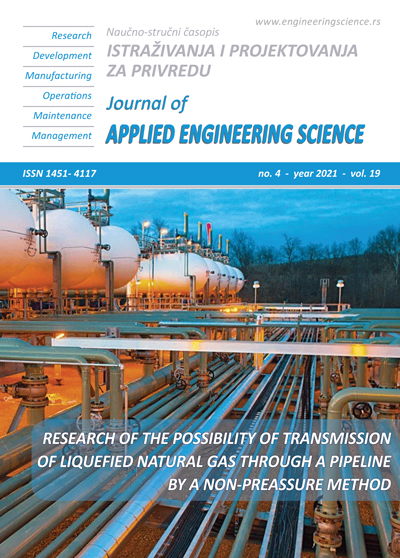EFFECT OF ZEOLITE ON THE CATALYTIC CRACKING OF TAR YIELDS MAHOGANY WOOD PYROLYSIS
Abstract
In this study, the effects of zeolite were observed to investigate the formation of a pyrolysis product, which is tar yield. Tar yields receive the most attention because of their potential as a bio-oil and chemical feedstocks. For this reason, efforts to increase tar yield were made, one of which was by adding zeolite to the pyrolysis process. The role of zeolite here was a pyrolysis catalyst. This research was conducted on a real pilot plant pyrolysis reactor which utilized mahogany wood as biomass feedstock with the addition of zeolite that was 0–50% of the total mass pyrolysis feedstock. The temperatures set in this pyrolysis were 250 °C, 500 °C, and 800 °C. The test results were measured in terms of the tar yield’s volume and mass. The chemical composition of tar yield was tested using a Gas Chromatograph Mass Spectrometry (GC-MS) to measure the percentage of its chemical constituent compounds. Then, the formation mechanism of tar compounds from pyrolysis was described by using HyperChem simulation. The results showed that an increase in zeolite catalyst percentage would generate more volume of tar yields. It was due to the breaking of biomass hydrocarbon chains, increasing the production of tar yields. Zeolite also affected the formation of hydrocarbon chains in tar yields where the chains became shorter as the percentage of zeolite catalyst rose. The mechanism of increasing tar product was due to the role of zeolite as a catalyst in the catalytic cracking process which is almost similar to acid-base reactions of Brønsted-Lowry and Lewis. This reaction took place when the pyrolysis yields moved through the pores of zeolite, breaking the long hydrocarbon chains into shorter ones which were dominated by alkenes, aromatic, and acidic compounds formation. In addition, acidic compounds represented by acetic acid function as a flammable matter possess the potential of becoming oil-fuel.
References
[2] Yanga, H., Yaoa, J., Chena, G., Maa, W., Yana, B., Qi, Y. (2014). Overview of upgrading of pyrolysis oil of biomass. Energy Procedia, vol. 61, 1306–309, DOI: 10.1016/j.egypro.2014.11.1087
[3] Busca, G. (2017). Acidity and basicity of zeolites: A fundamental approach. Microporous and Mesoporous Materials, vol. 254, 3-16, DOI: 10.1016/j.micromeso.2017.04.007
[4] Li, G., Pidko, E., A. (2018). The Nature and Catalytic Function of Cation Sites in Zeolites: a Computational Perspective. ChemCatChem Review, 134-156, DOI: 10.1002/cctc.201801493
[5] Kostyniuk, A., Bajec, D., Likozar, B. (2020). Catalytic hydrogenation, hydrocracking and isomerization reactions of biomass tar model compound mixture over Ni-modified zeolite catalysts in packed bed reactor. Renewable Energy, DOI: 10.1016/j.renene.2020.11.098
[6] Ahmed, T., Xiu, S., Wang, L., Shahbazi, A. (2018). Investigation of Ni/Fe/Mg zeolite-supported catalysts in steam reforming of tar using simulated-toluene as model compound. Fuel, vol. 211, 566-571, DOI: 10.1016/j.fuel.2017.09.051
[7] Wei, B., Jin, L., Wang, D., Xiong, Y., Hu, H., Bai, Z. (2020). Effect of different acid-leached USY zeolites on in-situ catalytic upgrading of lignite tar. Fuel, vol. 266, DOI: 10.1016/j.fuel.2020.117089
[8] Kong, X., Bai, Y., Yan, L., Li, F. (2016). Catalytic upgrading of coal gaseous tar over Y-type zeolites. Fuel, vol. 180, 205-210, DOI: 10.1016/j.fuel.2016.03.101
[9] Ahmed, T., Xiu, S., Wang, L., Shahbazi, A. (2020). Chapter 5 - FCC catalysts. Sadeghbeigi, R., Fluid Catalytic Cracking Handbook (Fourth Edition) An Expert Guide to the Practical Operation, Design, and Optimization of FCC Units, Butterworth-Heinemann publisher, 83-110, DOI: 10.1016/C2016-0-01176-2
[10] Yan, L., Liu, Y., Lv, P., Wang, M., Li, F., Bao, W. (2020). Effect of Brønsted acid of Y zeolite on light arene formation during catalytic upgrading of coal pyrolysis gaseous tar. Journal of the Energy Institute, vol. 93, no. 6, 2247-2254, DOI: 10.1016/j.joei.2020.06.007
[11] Kühl, Günter H. (1999). Modification of Zeolites. Weitkamp, J., Puppe, L. Catalysis and Zeolites Fundamentals and Applications. Springer-Verlag, Berlin, 81-197
[12] Wijayanti, W., Tanoue K. (2013). Char formation and gas products of woody biomass pyrolysis. Energy Procedia, vol. 32, 145-152, DOI: 10.1016/j.egypro.2013.05.019
[13] Yang, H., Yan, R., Chen, H., Lee, H., D., Zheng, C. (2007). Characteristics of hemicellulose, cellulose and lignin pyrolysis. Fuel, vol. 86, no. 12-13, 1781-1788, DOI: 10.1016/j.fuel.2006.12.013
[14] Wijayanti, W., Tanoue, K., Suetomi, T. (2011). Rule of thumb for simulating biomass pyrolysis in packed bed reactor. 11AIChE - 2011 AIChE Annual Meeting, Conference Proceedings
[15] Park, J., Lee, Y., Ryu, C. (2016). Reduction of primary tar vapor from biomass by hot char particles in fixed bed gasification. Biomass and Bioenergy, vol. 90, 114-121, DOI: 10.1016/j.biombioe.2016.04.001
[16] Rahimi, N., Karimzadeh, R. (2011). Catalytic cracking of hydrocarbons over modified ZSM-5 zeolites to produce light olefins: A review. Applied Catalysis A: General, vol. 398, no. 1-2, 1-17, DOI: 10.1016/j.apcata.2011.03.009

